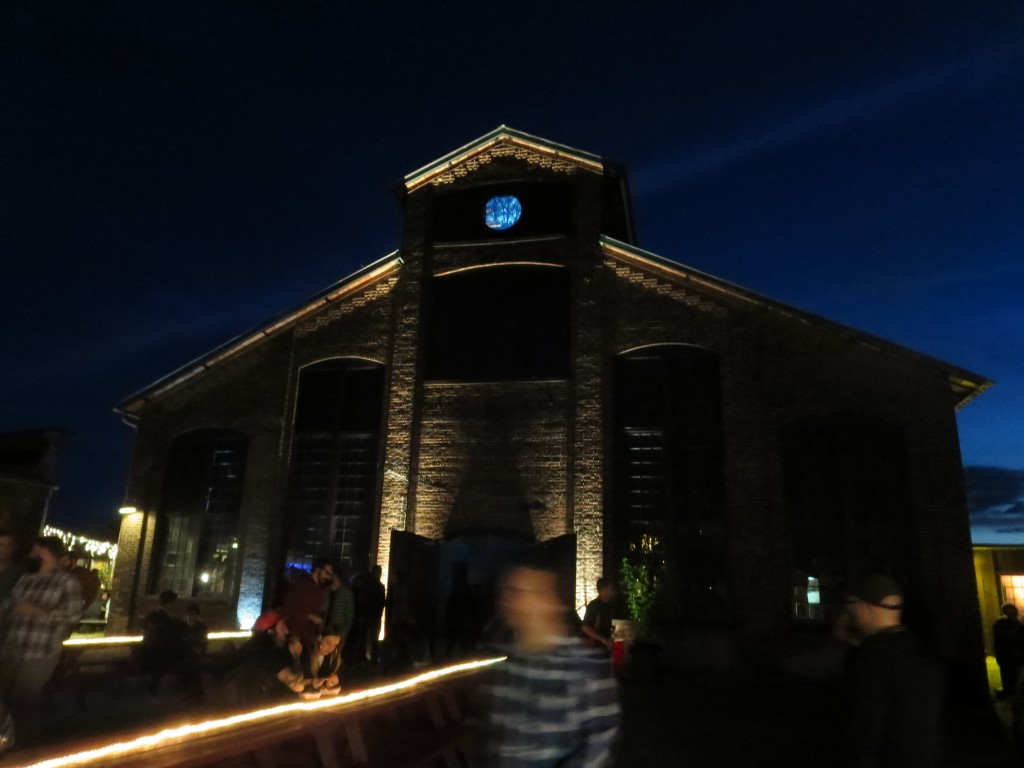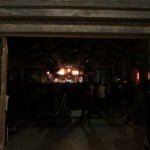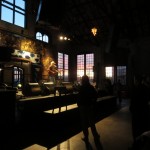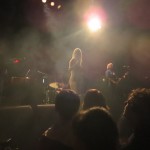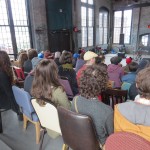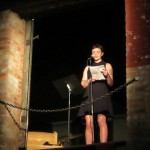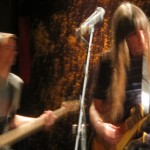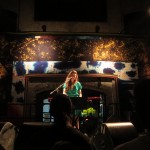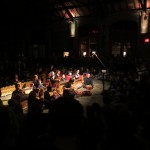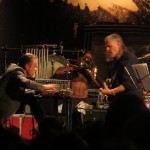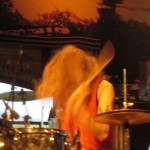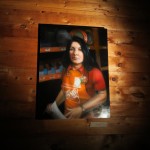Basilica Soundscape 2014
Now in its third year, Basilica Soundscape is one of the most exciting small-scale music and art festivals going. The event, sold out in advance for the first time, took place on September 12-13 at the Basilica Hudson in Hudson, a small, down-on-its-knees city in upstate New York that’s become a remote hotspot for the phenomenon known as “Brooklynization.”
- Basilica Hudson
- Friday’s line
The annual festival is the creation of Basilica Hudson’s proprietors, Melissa auf der Maur (former bassist from Hole) and independent filmmaker Tony Stone, who hand over two days of programming to NYC promoter Brian Deran and Pitchfork contributor Brandon Stosuy. Their mission is to avoid the obvious booking choices and festival formats, and to explore the possibilities of event- and site-specificity — useful virtues for a modest event in a venue that only holds 1,200 people. While 2012’s inaugural event served as proof of concept, last year was Basilica Soundscape’s coming out, generating an outpouring of positive reviews in the New York Times, the New Yorker, and other cultural gatekeepers. Visual arts, music-based performance art, and literary/poetry readings (mostly by musicians) round out excellent line-ups of exciting, often boundary-pushing indie-rock performers.Deran’s programming tends toward electronic psychedelia, Stosuy’s toward extreme metal, but this year these served only as starting points. Both show ingenuity in sequencing their line-ups for contrasts in aesthetic, genre and volume.
- Michael Chapman
- White Lung
Consequently, music listeners of almost all stripes and ages can discover a lot of new or overlooked sounds here with which to reassemble their iTunes collection. (With a weekend pass priced at $60, you might even have enough left over to afford the vinyl.) It helps that you don’t really have to be familiar with the music to appreciate the performances at Basilica Soundscape. Artists here tend to emphasize distinct sonic imprints: White Lung’s hardcore fury, Tim Hecker’s bracing fields of atmospheric noise, Endless Boogie’s droning hard rock. Others who traffic in more conventional songwriting — Julia Holter’s delicate art-school compositions, Majical Cloudz’ confessional electronics, 1960s British folk guitarist Michael Chapman’s open tunings — performed solo, creating tones and paces well suited for this cavernous building. The execution and presence of the music often stood out more than the works being performed.
- Melissa Broder (reading)
- Meredith Graves (reading)
As this suggests, the real star of Basilica Soundscape could be Basilica Hudson itself. The building hits the interior-design sweet spot between industrial decline and renovated restrooms. The larger grounds are pleasingly arrayed with film projections, extensive windows, and repurposed objects — not to mention food trucks, pop-up stores, and wi-fi – that invite listeners to observe and hear performances from different locations, the better to modulate the volume and recontextualize the concert experience.
- Endless Boogie
- Julia Holter
If there’s one serious criticism of Soundscape 2014, it’s that the organizers fell short in the value of site specificity that motivated prior years. Granted, it’s hard to match last year’s high point in this regard: composer Jonathan Bepler “conducting” simultaneous improvisations of power electronics (Pharmakon), headbanging EDM (Evian Christ), shoegaze (Julianna Barwick), and grindcore (Pig Destroyer) from different corners of the main room. Although event specificity (which this year included a moment of silence for Gaza, Ferguson and the latest U.S. bombing campaign) remains a Soundscape hallmark, this year it was left to artists’ own initiative to respond to their physical environment.
A few groups proved up for the task. Endless Boogie’s primal rawk jam (has a band’s name ever offered more truth in advertising?) echoed the hypnotic cacophony of the Fordist assembly lines that configured the factory building long ago. Guardian Alien, a drums and electronic duo, translated the stamp of machine press into the fifth dimension with Greg Fox’s jawdropping double-bass drum rolls and complex atemporalities. The shimmering wavelengths of Gamelan Dharma Swara sought to heal the factory’s scars, while the next night… well, Swans just punished that building, memorializing an American history of earth-ravaging and soul-crushing by destroying the sacred statues housed within.
- Gamelan Dharma Swara
- Swans
Why ask a cool weekend of music and art to meet the high-art standards of site-specificity? Because the site of Basilica Soundscape embodies several contradictions in the pursuit of ‘independent’ culture and place ‘authenticity’ today. In the event’s publicity, much is made of Basilica Hudson’s origins as a 19th-century wheel factory (apparently no one wants to remember its 20th-century use as a glue factory), but significantly overlooked is the turn-of-the-millenium proposal to zone the factory for the processing of perchloroethylene, a toxic dry cleaning solvent. Opposition to this proposal gave birth to a coalition of ecologists, ex-New Yorkers, and rabble-rousers under the “Friends of Hudson” banner. Their subsequent campaign to stop development of a 1,800-acre cement plant in neighboring Greenport punctuated local history, marking a shift from economies of land to economies of landscape. In this way, the site ushered in the political and environmental auspices for subsequent immigrations of artists, writers, and survivors of pre-Giuliani New York City that have visibly transformed Hudson, and that put events like Basilica Soundscape on the maps of cultural cognoscenti.
- Guardian Alien
- Marina Abramovic depicted in “Employee of the Month” (painting by Jim Krewson)
Brooklynization, they now call this process. Certainly, the baggage that ‘Brooklyn’ connotes is evident in the antique stores, farm-to-table diners, and coffeeshops along Warren Street, Hudson’s main commercial district. It almost goes without saying that these changes stop a few blocks north of Warren Street; about a quarter of the city’s population of six thousand remain unemployed. No one can reasonably blame Basilica Soundscape for this local ‘uplift’ — at least, you ain’t seen nuthin’ yet if the proposed Marina Abramovic Institute ever breaks ground. However, the opportunity to meditate upon place and local history is a precious commodity in a period when consumers’ music festival choices are increasing in number and predictability. Basilica Soundscape is especially well positioned to address the tensions between place and migration, between upstate solidarity and Brooklyn cool. It seems a shame not to more effectively seize that opportunity only three years in.
[Photos by Leonard Nevarez; right of attribution reserved.]

